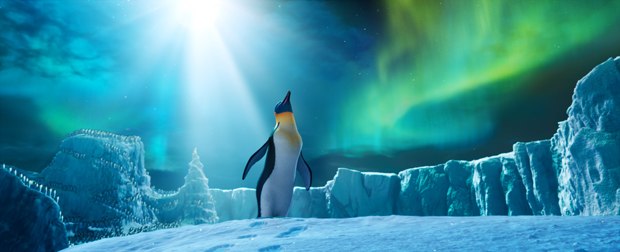Rob Coleman describes the challenges of Happy Feet Two, the sequel to George Miller's toe-tapping Oscar winner.
How ironic: Rob Coleman came to Industrial Light & Magic to make an animated feature with George Lucas and wound up supervising the animation for the three Stars Wars prequels before heading off to Singapore to get them up and running with the Clone Wars series. Meanwhile, the feature project stalled, and ILM got Rango going with Gore Verbinski, so Coleman went to Sydney to work on George Miller's Happy Feet Two, the sequel to the Oscar-winning penguin extravaganza, which is now competing against Rango for another Oscar.
But the offer was very enticing, indeed. After all, Miller had started his own animation studio, Dr. D, with a "story-driven" pipeline (migrating from Softimage to Maya), which meant a cutting edge feature with all sorts of creative and technical challenges.
As far as the penguins, Miller "wanted to put a lot of focus on the facial animation, the eye work and the dialogue beak/lip sync," Coleman explains. "The idea was that the animators got into the heads of the characters and that the creatures, both large and small, had convincing weight appropriate to their size.
"The software, hardware, pipeline, and processes are all in a new configuration from what we experienced in other studios," Coleman explains. "But the idea is to build on the 'best practices' from our collective previous experiences and hopefully build something better."
Likewise, Miller wanted much more dynamic lighting; more detail to every character and creature and landscape. In other words, he wanted to push the photorealism and needed the flexibility to lens it all more dynamically as well, especially in 3-D, where this was going to be more immersive and tactile.
But Miller didn't want the film to just get bigger and better in scale. He wanted to explore the near microscopic world under water to add a different point of view. So he created two hilarious new sidekicks, Will and Bill (voiced by Brad Pitt and Matt Damon), the Krill. They are bug-eyed, almost transparent and bioluminescent, and are the bottom feeders that break away from the swarm on an existential journey to discover the meaning of life.
Ironically, they are what attracted Coleman to Happy Feet Two in the first place. "When I came down here and George pitched me the movie and started going through the Krill story, I said I've gotta do this movie," he confirms. "And while most of the other part of this script evolved quite considerably over the last two years, the Krills virtually remained untouched. They had already written their lines. What Brad and Matt brought to it was a whole level of humor in terms of their vocal performances and how they riffed off each other in the recording studio.
"It was amazing to watch those two guys working together. But when Matt especially became Bill, and there was this extra longing to be with Will and his desire to have a family, and Brad's desire to be independent and no longer part of the swarm, it just made it funnier."
And it was obviously a challenge to animate the Krill. "They are very complicated rigs because they have 10 legs and 10 arms. From a facial performance position, they've got the big, long nose with the feelers out the front and then the round eyes. We spent a couple of months analyzing and then creating different movements for George, both swimming under water and running around on the ice. We tried everything from making them like dogs to horses, keeping all their legs together and moving them all apart. I know early on, George thought it was important that we see the humanity in them.
"So he put constraints on us. He did not want eyes on them like chameleons; he wanted independent eye movement and binocular eye vision like humans; they've got tiny eyebrows above their eyes, but, honestly, I never thought the audience would see those, so we spent a lot of time working with the angle of the eyes and the shape of the lids to get different expressions and the dilations of the pupils themselves. And then I was concerned that the audience wouldn't be able to read their mouths because their noses were so long so George spent a lot of time with the layout and lensing people to get the right angles on them way before we even started animating, and depth of field was also a challenge because they're so small. And what are they going to look like when they're moving around, so a lot of investigation with those guys. It was a lot of fun, too: all the animators wanted to animate the Krill."
Bill Desowitz is former senior editor of AWN and editor of VFXWorld. He has a new blog, Immersed in Movies (www.billdesowitz.com), and is currently writing a book about the evolution of James Bond from Connery to Craig, scheduled for publication next year, which is the 50th anniversary of the franchise.











